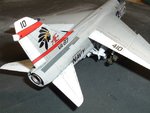I'm a non-conformant where panel lines are concerned. I use them but they are placed into the finished paint lightly and just barely suggested in an effort to keep everything about the model scale in appearance. I was looking for a site that could perhaps illustrate how I fill existing panel lines in molded parts and re-render them and found this. I thought it humorous and especially poignant with regard to the trends currently employed on the subject. These days I see lightly depicted airplane shapes superimposed over a heavy base of panel lines rather than the appropriate other way around. I happen to agree with this fellows spirit and aim to create in scale what we see rather than imagine we see.
PC Panel Lines
PC Panel Lines







